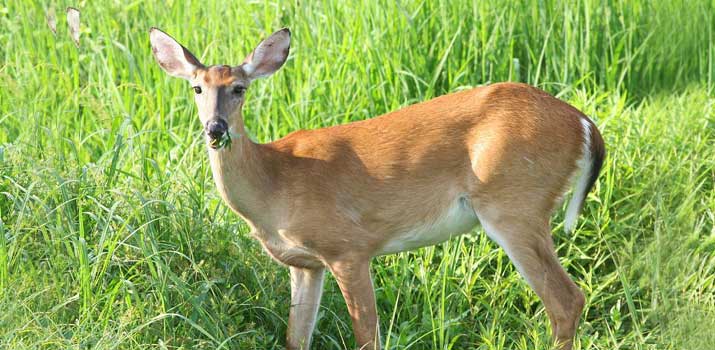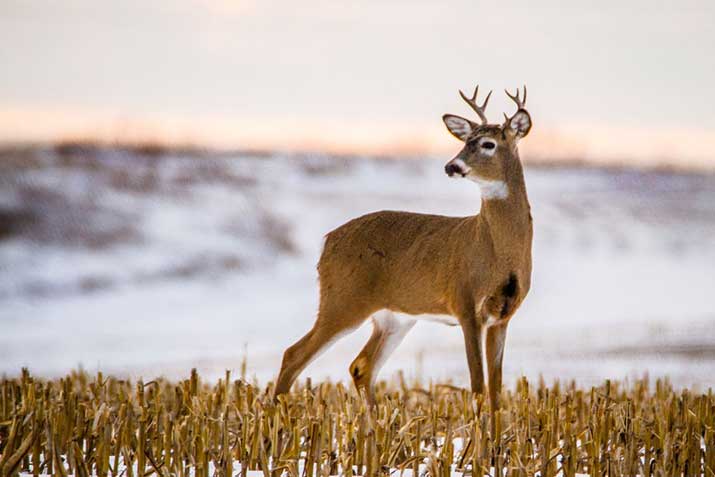
Deer are elusive at the best of times, so it’s almost completely unheard of to catch a glimpse of a pregnant doe, which is why so many of us know so little about the gestation period of these majestic and frightfully shy creatures.
Yet, as it happens, certain species of deer are polyestrous, meaning they go into heat a number of times in a single mating season, so there are almost certainly plenty of pregnant does around your local deer hotspot.
Now, being that deer rely on swiftness of hoof to survive, you might think that pregnancy would put does in significant danger, unless, that is, they enjoy a remarkably short gestation period.
Surprisingly, though, this isn’t at all the case… read on to learn how long a doe bears young.
Deer Gestation Periods
There are over 48 species of deer, so as you might expect, gestation periods will vary from species to species, but if we’re talking about the more common variants across the US, you’re looking at something between 180 and 200 days.
This translates to just over 6.5 months, and while that’s not quite as long as human gestation, it’s by no means a fleeting pregnancy, especially when you take nature’s shortest gestation periods into consideration!
The Virginian possum, for instance, will give birth to their young after only 12 days, and a hamster will go into labor after only 16–23 days.
But enough with the generalities… let’s dig into the nitty gritty with a species-by-species gestation period breakdown!
Species-By-Species Gestation Periods
- White-Tailed Deer = between 180 and 200 days — The most common throughout the US.
- Elk = between 240 and 262 days — Mostly found in the mountainous landscapes of western North America.
- European Roe Deer = 304 days (10 months), making this the longest gestation period of all deer! — Most prominent in Scotland and southern England.
- Red Deer = 236 days — A widespread species with habitats scattered across three continents.
- Sika Deer = 224 days — An Asian species found most prominently in Japan, Taiwan, and eastern Asia.
- Fallow Deer = 230 days — This species is found in Asia Minor and Europe but is quite plentiful in the US too, especially in Texas.
- Roe Deer = 290 days — Well adapted to cold environments, they enjoy high mountain land across a number of continents. Some are even found in southern Spain.
- Water Deer = between 170 and 210 days — There are two variants of water deer and can only be found in China and Korea.
- Barasingha = 245 days — An endangered species native to the Indian subcontinent of Asia.
- Reeve’s Muntjac = 214 days — Found primarily in the mountainous areas and woodlands of Southeastern China and Taiwan, although there are now notable populations in the Netherlands, England, and Ireland.
- Eld’s Deer = 240 days — The Eld’s Deer is indigenous to Southeastern Asia but historically also enjoyed wide distribution throughout a number of territories in Northeastern and Northern Asia.
- Thorald’s Deer = 263 days — Most prominent in eastern Sichuan, China.
- Bawean Deer = between 225 and 230 days — Unique to Bawean Island, Indonesia.
- Philippine Deer = 224 days — Endemic to the Philippines (as the name suggests), this species occurs on the islands of Luzon, Polillo, Catanduanes, Mindoro, Samar, Mindanao, and Leyte.
- Visayan Spotted Deer = 243 days — Another Philippine species, the Visayan deer is found exclusively in the rainforests of Visayan islands, Pany and Negros.
- Red Brocket = between 200 and 225 days — This species hails from the dense forests of South America, from northern Argentina to Columbia and The Guianas.
- Black Musk Deer = between 185 and 195 days — Found across Bhutan, China, India, Myanmar, and Nepal.
- Blackbuck Deer = 167 days — Blackbuck can be found across the grasslands and low-density forests of India and Nepal.
- Sambar Deer = 246 days — The Sambar deer is a relatively common species across South Asia, spanning Nepal, Bhutan, India, Burma, Thailand, Indochina, the Malay Peninsula, Indonesia, Taiwan, and southern China.
- Indian Muntjac = 210 days — One of the most widely distributed mammals in South Asia, the Indian muntjac can be found in Bangladesh, southern China, Sri Lanka, Nepal, northeastern India, Cambodia, Pakistan, the Malay Peninsular, Vietnam, Sumatra, the Riau Archipelago, Bangka Island, Java, Belitung, Borneo, and Bali.
- Tufted Deer = 181 days — These deer are mostly found in the high-altitude forests of China.
- Père David’s Deer = 286 days — Another Chinese native, Père David’s deer inhabit reed beds, grasslands, river valleys, and coastal marshes.
- Southern Pudu = 210 days — This species prefers the dense bamboo thickets and underbrush of temperate rainforests across southwestern Argentina and southern Chile.
- Javan Rusa = 250 days — Native to the Indonesian islands of Java, Bali, and Timor.
- Calamian Deer = 224 days — Only around 500 Calamian deer remain in the wild, occupying the forest edges, rivers, and marshes of a handful of Philippine islands.
- Pygmy Brocket = between 200 and 220 days — These cute little deer are distributed around South America, namely, Argentina, Paraguay, and southern Brazil.
- Marsh Deer = 260 days — This species inhabits many of the same locations as the pygmy brocket, with the addition of Bolivia, Uruguay, and Peru.
- Nilgai = 258 days — Major populations of Nilgai are found in Nepal, Pakistan, and India.
- Mule Deer = 203 days — Mule deer are a staple animal of western North America, stretching from the coastal islands of Alaska all the way to southern Baja.
- Moose = 243 days — Moose are found in Canada, Alaska, and New England.
- Reindeer = 222 days — Domesticated reindeer can be found around the globe, but they’re native to the northern Holarctic.
- Chital = 227 days — Chital deer are native to India and Sri Lanka.
- Indian Hog Deer = 220 days — Native to the Indo-Gangetic Plain, Indian hog deer are found in Pakistan, Nepal, northern India, Bangladesh, and all the way through to the Southeast Asian mainland.
- Northern Pudu = 210 days — Native to the Northern Andes, you’ll find this species in Venezuela, Columbia, Peru, and Ecuador.
- Taruca = 236 days — Teruca are found in the Andes mountains exclusively.
- Bornean Yellow Muntjac = 213 days — This species is endemic to the low hills and coastal areas of Borneo.
- South Andean Deer = 213 days — An endangered species native to the Argentinian and Chilean Andes.
- Fea’s Muntjac = 196 days — A particularly rare species, it can only be found in Thailand, the Tenasserim Mountains, and a select few locations in southern Myanmar.
- Brown Brocket = 220 days — You’ll find this diminutive species in Mexico, Belize, and Guatemala.
- Siberian Musk Deer = 176 days — This species prefers the mountain forests of Northeast Asia.
Siberian Roe Deer = 290 days — The Siberian roe deer is widely distributed throughout Eastern Europe and continental Asia.
Why Do Different Species Of Deer Have Different Gestation Periods?

There are bound to be individual differences in gestation period even between does within the same species.
But when it comes to the significant differences in pregnancy duration between species, we have to look beyond the individual and consider larger contributing factors.
It’s thought that the primary reason for differing gestation periods amongst, not just species of deer, but between all families of animals and their various species, is the environment in which they live.
Simply put, the longer the gestation period, the more time the fawn has to develop, meaning it’s more prepared for the rigors of the habitat when born
How To Tell If A Doe Is Pregnant
Usually very slender animals, you’d think you’d be able to spot a pregnant doe from a mile off, but, although they do change physically, they don’t start “showing” until deep into the third trimester, so it takes a trained eye to identify a mother-to-be.
With that in mind, let’s get that eye of yours trained up!
Here’s what you’re looking for:
- A small-to-large bulging of the lower abdomen
- Excessive grooming, i.e. licking of the fur, especially around the abdomen
- Eating out in the open. When with fawn, mother does have to eat plenty of food to facilitate the development of their young. This might mean venturing outside what they consider safe grazing zones and is part of the reason they may exhibit enhanced alertness.
- Other pregnant does. If you can see a couple of does that definitely look pregnant, chances are that any does with them that don’t look pregnant are as well, as expecting mothers tend to travel together.
You should also consider the time of year when trying to deduce if a doe is pregnant or not.
Should your spotting occur during early-to-mid spring, the doe or does in question are almost certainly pregnant, as at this point, the rutting season has been and gone, and most does are eating for two… as the saying goes.
Where Do Deer Give Birth?
Deer look for spots under cover of lots of long grass and plant life to give birth to what is usually 1 or 2 fawns, although a litter of 3 isn’t completely unheard of.
After giving birth to, cleaning, and feeding her young, a doe will spend long periods of time away from their hiding spot in order to discourage predators from snooping around.
Final Thoughts
Does have a hard time of it when with fawn. Not only do they have to survive with diminished agility, they have to live more dangerous lives in order to reach enough food to support their growing offspring.
Now, considering deer are uniparental animals, meaning once the buck has played his part he takes off for good, I think it’s fair to say that the fact does carry their young for roughly 200 days on average is nothing short of astounding!
